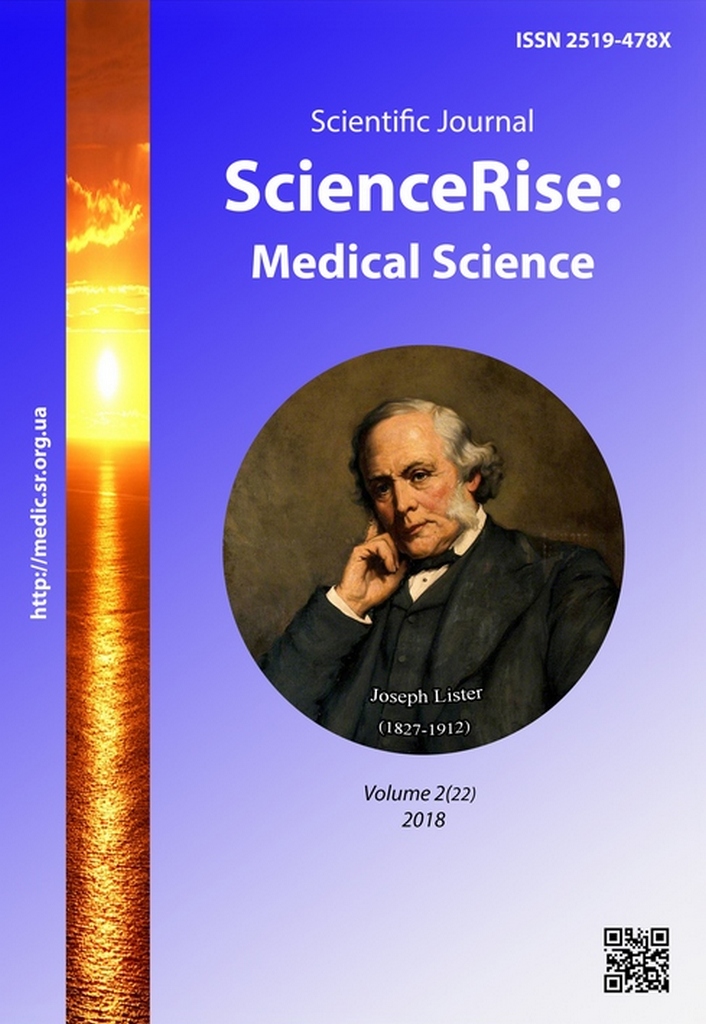Dynamics of psychopathological disorders and level of social functionality in patients with schizophrenia under complex treatment
DOI:
https://doi.org/10.15587/2519-4798.2018.124868Keywords:
art therapy, patients with schizophrenia, social functioning. positive, negative, general psychopathological syndromes, coping strategiesAbstract
Aim of the research: Assessment of the effectiveness of art therapy in the system of therapy and rehabilitation of patients with schizophrenia.
Objects and methods: During the study, a comprehensive clinical-psychopathological and psychodiagnostic study of 125 patients, both sexes, at the age of 20-45 years (average age 35.0±2.0 years) with diagnosed schizophrenia in the stabilization of the condition was performed. The main group (who took part in art therapy) was 95 people (54 women and 41 men). The control group included 30 patients (16 women and 14 men) who received standard regulated therapy in the hospital.
Results. In the course of the study, the system of art therapy in the complex therapy of patients with schizophrenia was proposed and their effectiveness was proved.
Under the influence of art therapy in the complex treatment of schizophrenia, rapid reduction of psychopathological symptoms, normalization of the emotional state, stabilization of patients' behavior, improvement of cognitive parameters, increase of psychophysical activity of patients is noted, which is confirmed by data of dynamic analysis of clinical and psychopathological violations on PANSS scale.
There is a pronounced positive dynamics of the level of social functioning in patients with schizophrenia, which included in the traditional complex of treatment and rehabilitation measures art therapy on the scale of general behavioral dysfunction, dysfunction when performing social roles in society; functioning of patients in the hospital and dysfunctional modifying factors.
Conclusions. Under the influence of art therapy in the complex treatment of schizophrenia, a rapid reduction in psychopathological symptoms, an increase in the duration and quality of remission is observed, which is confirmed by the data of the dynamic analysis of clinical and psychopathological disorders on the PANSS scale.
Against the background of art therapy in 82.2 % of patients with schizophrenia was achieved a stable therapeutic effect, 11.1 % - the state remained without dynamics, and 6.7 % - there was a relapse of the disease. In patients with schizophrenia, optimization of the coping strategy of problem-solving behavior with the predominance of coping-oriented problem solving is noted.
References
- Dyhtyar, V. O. (2009). The level of social functioning and quality of life as the basis of psychotherapy for patients with paranoid schizo-freesia. Ukrainian Journal of Psychoneurology, 17 (3 (60)), 35–44.
- Voloshin, P. V., Maruta, N. O. (2015). Mental Health Protection Strategy of the Ukrainian Population: Contemporary Opportunities and Obstacles. Ukrainian Journal of Psychoneurology, 23 (1 (82)), 5–11.
- Maruta, N. A. (2011). State of Provision and Prospects for the Development of Psychiatric Care in Ukraine. Archive of Psychiatry, 17 (3 (66)), 5–9.
- Kolyadko, S. P., Kalenska, G. Yu. (2017). Features of the use of art therapy in the treatment of patients with paranoid schizophrenia. Ukrainian Journal of Psychoneurology, 25 (1 (90)), 51–55.
- Gumenyuk, L. N., Mikhailova, E. A. (2010). Art therapy in the system of complex psychosocial rehabilitation of schizophrenic patients in conditions of compulsory treatment. Tauric medico-biological Journal, 4, 37–40.
- Kozhina, A. M., Markova, M. V., Krishtal, A. A., Kostousov, A. A. (2013). Effektivnost art-terapii v kompleksnom lechenii bolnykh shizofreniyey. Mіzhnarodniy medichniy spetsіalіzovaniy naukovo-praktichniy zhurnal, 6 (1 (19)), 45–47.
- Pushuk, N. G. (2010). Predictors of the process of psychosocial rehabilitation of the mentally ill. Ukrainian Journal of Psychoneurology, 18 (3 (64)), 145.
- Mazhbits, V. B. (2012). Differentsirovannaya psikhosotsialnaya reabilitatsiya ambulatornykh bolnykh paranoidnoy shizofreniyey. Eksperimentalna і klіnіchna meditsina, 4 (57), 119–123.
- Markova, M. V., Kosenko, K. A. (2014). Psykhoterapiia v kompleksnomu likuvanni zhinok, khvorykh na paranoidnu shyzofreniiu, pry riznykh modeliakh rodynnoi vzaiemodii: obgruntuvannia, zahalni pidkhody, spetsyfichni osoblyvosti. Ukrainskyi visnyk psykhonevrolohii, 22 (3 (80)), 69–73.
- Dryuchenko, M. O. (2016). Osoblivostі klіnіko-psikhopatologіchnoi simptomatiki paranoidnoi shizofrenіi u zhіnok v kontekstі ikh vplivu na stan materinsko-dityachoi vzaemodіi. Medichna psikhologіya, 4 (44), 78–84.
- Korostiy, V., Hmain, S. (2015). Art-therapy in Complex Treatment of Major Depressive Disorder. European Psychiatry, 30, 1324. doi: 10.1016/s0924-9338(15)31033-6
Downloads
Published
How to Cite
Issue
Section
License
Copyright (c) 2018 Alexandr Krishtal

This work is licensed under a Creative Commons Attribution 4.0 International License.
Our journal abides by the Creative Commons CC BY copyright rights and permissions for open access journals.
Authors, who are published in this journal, agree to the following conditions:
1. The authors reserve the right to authorship of the work and pass the first publication right of this work to the journal under the terms of a Creative Commons CC BY, which allows others to freely distribute the published research with the obligatory reference to the authors of the original work and the first publication of the work in this journal.
2. The authors have the right to conclude separate supplement agreements that relate to non-exclusive work distribution in the form in which it has been published by the journal (for example, to upload the work to the online storage of the journal or publish it as part of a monograph), provided that the reference to the first publication of the work in this journal is included.









